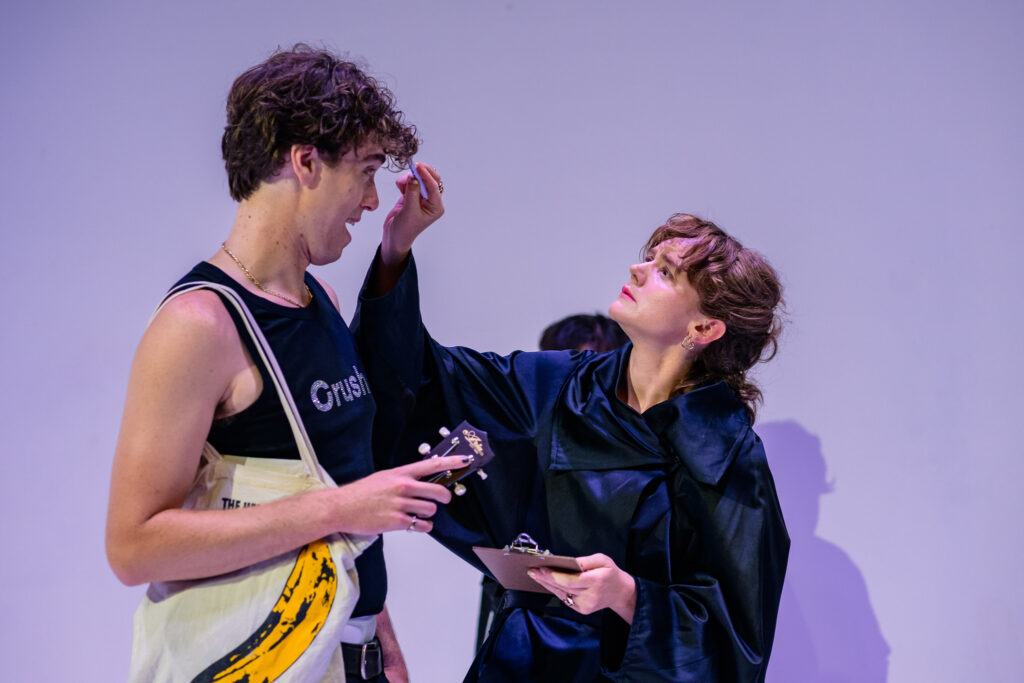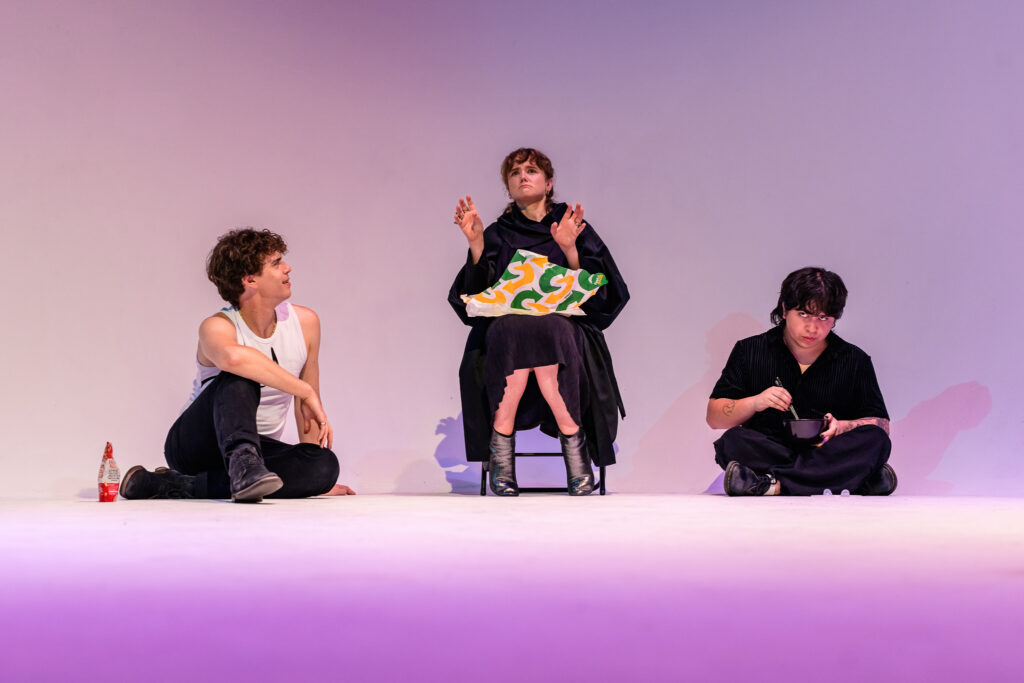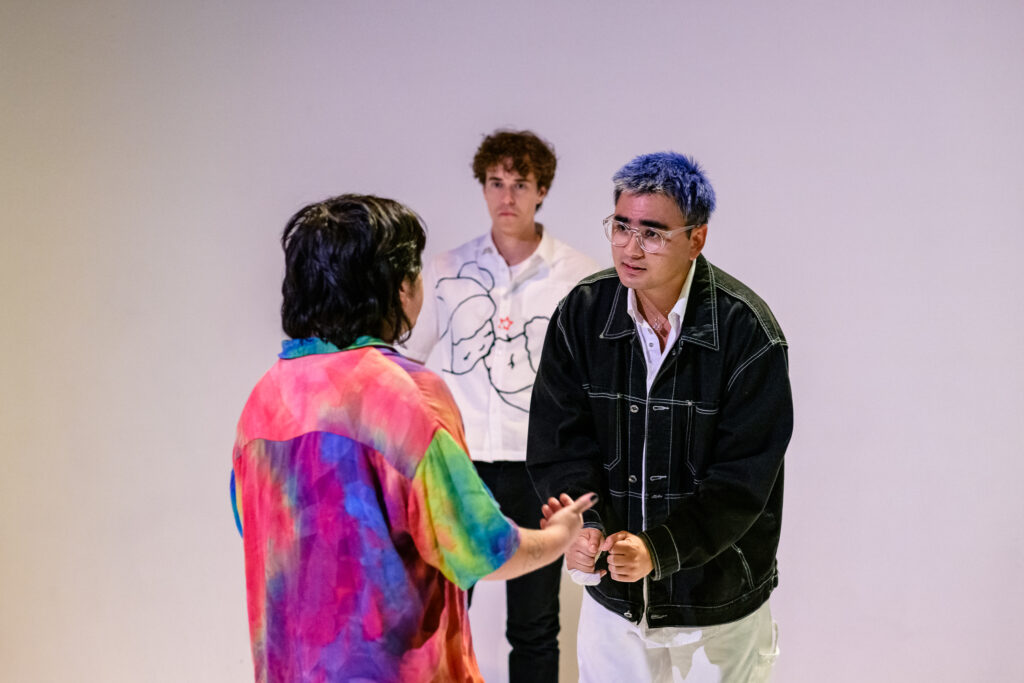Spoilers ahead! This response will discuss elements of the show that could be considered spoilers. You have been warned.
At first blush, The Perfect Image is a queer rom-com. This is, as you’ll find out by watching, a pretty shallow reading of a rich text, but I do want to recognise Sam Brooks’s creation of such a charming conceit within the confines of a four-person play. It kicks off with a meet-ugly between our protagonist Brit (Sean Rivera) and the new hire Ryan (Michael Hockey) at their workplace: a stock image company that promises diversity through their inclusion of people of colour in their pictures. The twist: Ryan is a person of non-colour (as the manager hackishly calls him), and kind of annoying to boot. But even as Brit rants to his boyfriend Des (Mark Chayanat Whittet) in asides set in their shared apartment, Ryan haunts the backdrop, quite literally. He often stands centre-stage, unspeaking; even when he’s not in-scene, he’s taking up space in Brit’s mind.
From the starting point of the absurd setting, The Perfect Image hearkens back to the golden age of rom-coms, where everyone has nebulous careers in offices (see also: the boyfriend’s job in ‘emails’). The manager (Amelia Reynolds) is quixotic in her asides, as much as she is blithely problematic (read: racist and/or homophobic, but disarmingly comfortable in being so), and her outfit aspires to Miranda Priestly levels of office couture. At the crux of the play, the protagonist and his love interest are trapped together due to a power cut. Fantastic! It did take me some time to settle in and suspend belief, but by the time I did, I was fully immersed. In particular, I was hooked by the romantic tension that the leads expertly bring to a rolling boil by the time they’re forced to confront what has grown between them.

Unlike the standard rom-com, however, the twin forces of racism and capitalism are ever-present menaces. The protagonist’s solipsism appears to stem (at least partially) from his experience of being mixed-race and the fact that his current employment is based on his capacity to pass as whatever the stock image requires. At times, the protagonist’s view feels so myopically consuming that the rom-com elements fade into the background. This is how The Perfect Image conveys that we’re not just here for escapism. There’s a lot to be said on this, and it’s said well by Jake Tabata for Rat World.
Also unlike a typical rom-com, there’s no neat conclusion. When it’s all done, and the actors take a bow, relationships remain unsettled. Brit seems to have arrived back at the beginning and still has all the baggage he started out with. In this way, it reminds me of My Best Friend’s Wedding—if only because the girl doesn’t get her man, and is given carte blanche to be a bit awful along the way. I wouldn’t call Brit awful, but he is complex, and willfully so at times—whether he’s antagonising his new love interest, or evading his boyfriend’s efforts to encourage him back into acting. In particular, I found the boyfriend’s anguish at his partner’s self-loathing painfully realistic, even as he jokingly refers to the protagonist as ‘Master’.

I think it’s a very parochially Pākehā perspective to particularly notice how the white characters are set up, but the white love interest, Ryan, really got through to me. In particular, his capacity to be extremely charming while totally lacking in self-reflection was interesting. In most rom-coms, a witty antagonist-cum-love-interest will usually undergo a journey of self-reflection on the way to love (I’m thinking of How To Lose a Guy in Ten Days, or You’ve Got Mail). That doesn’t happen here. When the Brit tells Ryan (in the classic locked-room scene) that he’ll have to tolerate rants about whiteness, he affably replies that he’ll tune them out. Maybe my literalism is showing, but I found that a convincing turn—even as he is capable of being the romantic lead, of expressing love sincerely and beautifully, he isn’t capable of interrogating his fundamental whiteness. I would say that dooms the relationship to failure but again, at the end, all the cards are still on the table. We’ll never know how our protagonist chooses to play them. Fantastic.
Likewise, the manager plays foil to Brit’s general misanthropy, as well as his contempt for his job. She is capable of being as profound as she is absurd—she gets a monologue on the particulars of Subway sandwiches, and she gets the closing line of the play if I remember correctly. It’s a generous take on the whimsical cruelty of middle-management, and it belies Brooks’s charming writing—he lets these characters have their insights, but he won’t let them off the hook.

Though I’m not privy to the ins and outs of venue booking, I also thought the use of LOT23 for the production worked well. The tall ceilings and stark white backdrop brought light into the space, but it didn’t feel particularly comfortable. I don’t think that was just the usage of vintage school benches for seating; it was more the kind of brightness that makes you feel a bit naked, or it does if you’re a recluse like myself. In attending The Perfect Image, I felt exposed, I felt out of my element and, in the end, I was so glad I went. If it’s shown near you, and you have the chance, do go along. It’s messy and it’s difficult and it’ll make you laugh; I’m sure you’ll have a good time.
Featured photos by Jinki Cambronero.



